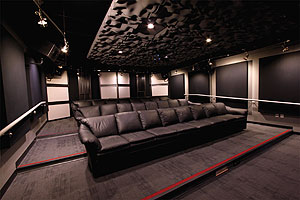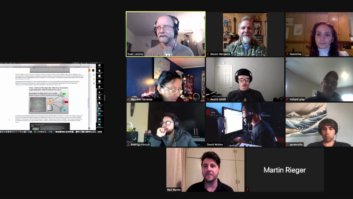
The rear wall of Naughty Dog’s Media Room, which incorporates designer Chris Pelonis’ trademarked The Edge acoustical system
Photo: Chris Pelonis
Videogame sound production has come so far so fast these past few years that it’s easy to forget it’s still an industry in its infancy. It didn’t come of age within a studio or network system, although dominant publishers and platforms have emerged. It didn’t start out with any rules of production, such as those that might be handed down by a guild or apprentice system, though a guild has been established to boost the level of professionalism and resources industrywide. Engineers didn’t really have the right tools to do the job in the beginning, instead borrowing from record and TV and film production to get the job done while middleware was being developed
to free up creatives from their code-writing
brothers and sisters. And the facilities, with a few
notable exceptions, didn’t really exist to bring all
the disparate audio assets together to handle the
complexities of the increasingly complex 5.1—now
7.1—surround mixes.
But all that is changing, somewhat slowly over
the past decade but definitely accelerating during
the past few years. Microsoft built some sweetsounding
rooms to go along with the acquisition
of Bungee, built on the success of Halo. Electronic
Arts has gone through a couple of incarnations
now in its audio suites in Redwood City, Calif., and
up in Vancouver. But nobody has done it quite like
Sony Computer Entertainment of America, which
has built a network of powerhouse audio design,
edit and mix rooms in California during the past
six years, from San Diego up to Santa Monica on
through to Foster City. Sony’s latest—the Media
Room/Theater in the new 45,000-square-foot Santa
Monica offices of Naughty Dog, a wholly owned
subsidiary—is pictured on this month’s cover.
Naughty Dog has been one of the world’s
premier game developers since emerging in 1994
with the highly acclaimed and huge selling Crash
Bandicoot series for PS 1. PS 2 brought Jak and Dexter,
but it was PS 3 that put them over the top with
a character named Nathan Drake and the hugely
popular Uncharted 1 and Uncharted 2: Among
Thieves. The latter, released in October 2009, has
sold well over 4 million units and swept awards
shows worldwide, including Best Game, Best Art
Direction and Best Sound at Game Developers
Conference 2010 in February. The demands to
keep up with expansion packs and online versions,
not to mention new titles, led Naughty Dog into
its new digs, which was occupied this March.
The Media Room, a 7.1 presentation/mix
theater, was designed by Chris Pelonis, the TEC
Award–winning, Santa Barbara–based designer/
acoustician who has now designed 45 production
and mix rooms for Sony worldwide, most
of which house his monitors. Pelonis, a first-rate
guitar player and self-taught acoustician, has now
designed somewhere in the neighborhood of 500
spaces, from control room/studios to nightclubs
to home theaters to dub stages and mastering
rooms. He has certainly refined his techniques
and implementation during the years, yet he incorporates
the same basic principles that led him
into the business back in the mid-’80s, when he
patented The Edge: a somewhat revolutionary
acoustical device with multiple attributes, but primarily
a low-frequency control device.
“The Media Room is a relatively large room,
about 830 square feet, but it isn’t really all that
different from what I might design for a mastering
room, a control room, a home theater or any
critical-listening space,” he explains. “Part of my
signature, if I have one, is that I like a large sweet
spot, and because of my approach to low-frequency
control, I don’t get the low-frequency buildup
and boundary interference that is typical in listening
spaces, regardless of the size. Obviously, here
we had to accommodate a lot of seating, sometimes
up to 30 people on couches, and there is a
zone where the energy is more focused, but that
has more to do with the trajectory of the speakers
and focal point/listening position of the multichannel
system. Having said that, everyone in the
room is still intimately involved in the playback.
The combination of consistent off-axis phase and
frequency response of my speakers [35-plus degrees]
and well-designed acoustical control is the
recipe for ‘not a bad seat in the house.’”
“Chris did an awesome job,” says Justin
Monast, Naughty Dog director of information
technology, who has been with the company
since Crash Bandicoot 1. “And he had to teach
me about sound. We had mixed in conference
rooms before, with steel doors leaking into the
offices. This time around, we wanted to do it
right. We gave him a predefined space for six
5.1 production rooms and a 5.1/7.1 theater, and
he worked within our constraints. We couldn’t
float all the floors, for example, and we had to
use metal studs, not wood like he would prefer.
But he really wants to build a room that he would
listen to.”

Justin Monast, Naughty Dog director of information technology
Naughty Dog occupies a full floor within a
five-story building in Santa Monica’s Water Garden
area. Isolation was a focal point from the early
meetings, as was HVAC and electrical. (Pelonis is
an avowed fan of balanced power.) From the first
meetings, Naughty Dog made it
clear they needed the Media Room
to be something for everyone. It had
to be able to show dailies, host training
exercises and serve as a meeting
place for brainstorming between
and within departments. It needed
to show the latest titles and updates
in press previews and serve as a final
mix room. And, of course, people
needed to play games. But it was
clear they wanted a first-rate theater,
not a multipurpose room.
“One of the things I really pushed for was
couches in segments instead of the typical seating
in a theater, with director’s chairs and captain’s
chairs and the editor and three or four people discussing
a movie,” explains Monast. “With games,
you might have 30 employees talking about certain
aspects of the levels with animators and programmers.
So for that many people, it’s a much more
inviting and comfortable area. There are actually
two sweet spots in the room, for 5.1 and 7.1, and
his subs are just amazing. We’ve had the composers
who scored the Uncharted games come in,
and they were just blown away.”
“Low end is a given any time you work with a
game company, and they definitely need to hear
it correctly,” Pelonis says, calling it, with a wink
and a nod, a 7.2 room because of the two Pelonis
Signature Series subs. “The stuff that these guys
play isn’t wimpy. The low frequencies are the most
difficult and problematic to deal with in any room.
They’re also the big determiner of whether you get
a nice, wide sweet spot or a small, confined sweet
spot. By reducing boundary interference with welldesigned
and well-located acoustical systems, the
typical bass buildup—the pressure zones as I like
to call them—is mitigated.”
The “acoustic system” Pelonis refers to is
The Edge. Basically, it provides a very gradual
transition from absorption to dispersion and
diffusion as the frequency rises. As the system
becomes more reflective, it transitions into
dispersion as a result of this faceted geometric
condition, similar to the varying well depths of
a Quadratic Diffusor. While he has never been
a big proponent of back-wall diffusion, he says
there is an inherent diffusion and dispersion
characteristic in The Edge without the splashback
in the mid to high frequencies.
“You will find some diffusion occasionally
on my back walls, and I’m not at all saying that
is a wrong approach,” Pelonis explains. “But
you have to be cognizant that if you get in the
proximity of where all this phase gradient is occurring,
you will find your head swimming in a
comb filter. That said, I do have some of Peter
[D’Antonio’s] diffusors back there, but probably
less than a quarter of what you might see in
other rooms. If you think of The Edge creating
a ‘W’ on the back wall, in this case, the valleys
of the ‘W’ are where I added diffusion. Over the
past 25 years, I’ve learned to blend the rest of
the room into the system so that every aspect of
the room is more meaningful acoustically than
maybe what it was when I started.”
Pelonis had just shy of 12 feet height to work
with within the isolation shell. There is trapping
in the ceiling, as would be expected, and he incorporated
some proprietary new techniques
for dealing with absorption along the soffited
speaker wall, a common trouble area where front
meets side.
Pelonis Signature Series speakers, built and
distributed by Tannoy, are used throughout the
room, with three passive PSS 110s across the front
and two on each side, placed for optimum 5.1 and
7.1 listening positions. (“I don’t like them less than
100 degrees off the center of the front wall for 5.1,”
Pelonis says. “And I prefer in the 115 to 117-degree
range.”) The PSS 12LF subs are flush-mounted as
well and were doubled up to maintain the impact
throughout the room. All amplification and processing
is also by Pelonis.
“The team at Sony Computer Entertainment
is really top-shelf, and we’re pretty fine-tuned at
this point,” Pelonis concludes. “They’re extremely
efficient from a design-build perspective, and I’ve
learned to value working with people who not only
have experience, but who understand what I’m after
when I sit down to listen to a room.”
Tom Kenny is the editorial director of
Mix.







